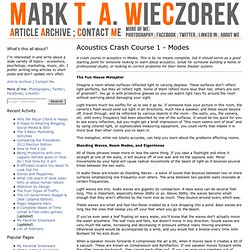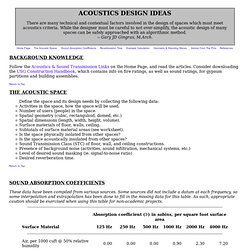

Green Schools. Room Acoustics. Privacy & Intelligibility. Modes. A crash course in acoustics in Modes.

This is by no means complete, but it should serve as a good starting point for someone looking to learn about acoustics. Great for someone building a home or professional studio, or looking to correct problems for their home theater system. The Fun House Metaphor Imagine a room whose surfaces reflected light to varying degrees. These surfaces don't reflect light perfectly, but they all reflect light. Light travels much too swiftly for us to see it go by. This metaphor, while not totally accurate, can help you learn about the problems affecting rooms. Standing Waves, Room Modes, and Eigentones All of those phrases mean more or less the same thing.
In audio these are known as Standing Waves - a wave of sound that bounces between two or more surfaces emphasizing one frequency over others. Light waves are tiny. Treble waves are small and fast like those created by a rock dropping into a pond. You can calculate the length of a sound wave fairly easily. Acoustics Design Ideas. Follow the Acoustics & Sound Transmission Links on the Home Page, and read the articles.

Consider downloading the USG Construction Handbook, which contains info on fire ratings, as well as sound ratings, for gypsum partitions and building assemblies. Return to Top Activities in the space, how the space will be used. Number of users (people) in the space. Spatial geometry (cubic, rectanguloid, domed, etc.) These data have been compiled from various sources. The length of time required for the intensity (volume) of sound in a space to fall by 60 dB is the reverberation time (notation: RT60) of the space. Where: RT60 = reverberation time, in seconds V = volume of the space, in cubic feet A = total absorption of the space, in sabins Absorption of sound energy by materials is dependent on the frequency (Hz) of the sound.
Calculate the areas of all surface materials, including furnishings. Now calculate the reverberation time: RT60 = (9 * 15 * 8) / (20 * 66.58) = 0.81 seconds. Small Room Acoustics. Small Room Acoustics (Sound Theory) Last updated on 7/08/10 (simplified, expanded, errors corrected) The most commonly overlooked aspects of a recording studio is the acoustics.

Acoustics is the behavior of sound. Sound refers to waves of compression/decompression travelling through any medium. Without good acoustics, it is almost impossible to get a good recording, mix or master. Reflections are probably the most important aspects of acoustics. In the natural world without walls or ceilings, the First Significant Reflection will always come from the ground. Having several open microphones in a given environment can have the same effect as a reflection.